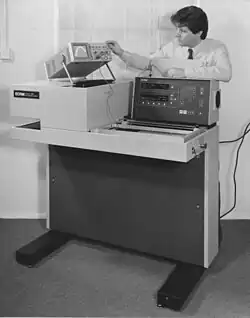Autokon
 Autokon 1000/DE | |
| Manufacturer | ECRM, Inc. |
|---|---|
| Introduced | 1975 |
| Type | Image scanner (flatbed) |
| Connection | SCSI (some models, aftermarket) |
| Dots per inch | 1000–2000 (lines per inch) |
Autokon is a discontinued line of image scanners sold by ECRM Inc., a subsidiary of AM International, from the 1970s to the 1990s. The inaugural Autokon 8400, introduced in 1975, was the first flatbed scanner used for digital image processing.[1][2][3] In the print industry, the Autokon was considered a milestone in the transition to from manual to electronic pagination.[4] Numerous models were released over the span of two decades, and the Autokon line as a whole enjoyed widespread use in the newspapers and prepress industries, becoming a de facto standard for image scanners in the time before the desktop publishing revolution of the mid-1980s.[5]
History
The Autokon 8400, introduced in 1975, used a laser beam to scan pages up to 11 by 14 inches at a maximum resolution of 1000 lines per inch. Although it was only capable of scanning in 1-bit monochrome, the on-board processor was capable of halftoning, unsharp masking, contrast adjustment, and anamorphic distortions, among other features.[3][6]: 53 The Autokon 8400 could either be connected to a film recorder to create a negative for producing plates or connected to a mainframe or minicomputer for further image processing and digital storage.[6]: 53 [7] The Autokon 8400 enjoyed widespread use in newspapers—ECRM shipped 1,000 units to newspaper publishers by 1985[2]—but its limited resolution and maximum scan size made it unsuitable for commercial printing.[1]
In 1982, ECRM introduced the Autokon 8500, capable of scanning up to 1200 lines per inch. Four of ECRM's competitors introduced commercial flatbed scanners that year, including Scitex, Agfa-Gevaert, and Linotype-Hell, all of which were capable of scanning larger prints at higher resolutions.[1] The Autokon 1000, introduced in 1984, came to support scanning up to 2000 lines per inch as well as the ability to scan in color with hardware enhancements.[8][9][10] The Autokon 1000 gained support for connecting to personal computers in 1988 when ECRM announced a kit for the Macintosh II, comprising a SCSI buffer expansion board and software, that allowed the Macintosh II to control and ingest image data (formatted as TIFFs) from the Autokon 1000; it supported monochrome data only. ECRM simultaneously announced an add-on raster image processor for the Autokon 1000, allowing it to output PostScript-compliant image data to computers and to printers such as the LaserJet.[10][11]
In 1988, ECRM introduced the 1000/DE (digital enhancement),[12] which used a microprocessor to produce the sharpening effect as against the 8400 which used analog electronics and an optical method to create sharpening. The Autokon 1000/DE had a touchpad rather than analogue rotary controls. The Autokon 1000/DE had applications in both commercial and newspaper environments where only a single halftone was required, i.e. black and white. While typically the Autokon 8400 was a standalone output device that scanned and then output to either photosensitive, roll format bromide paper or film, the Autokon 1000/DE was often connected to Macintoshes or IBM PC compatibles via a dedicated interface such as those from HighWater Designs. The last Autokon was a wider format, online-only device which utilized both a red and green laser to improve the response to the scanning of color photographs.
ECRM continued selling Autokons into 1995.[13] The line disappeared from the comapny's catalog between then and 1998.[14] After selling its remaining platesetter assets to Kodak in 2021, ECRM quietly dissolved.[4][15]
See also
- Datacopy Model 700, the first flatbed scanner for the IBM Personal Computer
- History of image scanners
References
- ^ a b c Bruno, Michael H. (May 1983). "Solving the Equipment/Technology Equation". American Printer. 191 (2). Maclean Hunter Publishing: 31–35 – via Google Books.
- ^ a b Bruno, Michael H. (October 1985). "Scaling the Heights of High Technology". American Printer. 196 (1). Maclean Hunter Publishing: 39–43 – via Google Books.
- ^ a b Banks, W. H. (1984). Advances in Printing Science and Technology: Proceedings of the 17th International Conference of Printing Research Institutes, Saltsjöbaden, Sweden, June 1983. Pentech. pp. 63–64. ISBN 978-0-7273-0109-3 – via the Internet Archive.
- ^ a b Staff writer (April 20, 2021). "ECRM 'rests' at 50, selling platesetter business to Kodak". GXpress. MPC Media. Archived from the original on August 11, 2025.
- ^ Staff writer (August 30, 2009). "ECRM turns 40 and recalls its OCR and Autokon roots". GXpress. MPC Media. Archived from the original on August 11, 2025.
- ^ a b Wallis, L. W. (1988). A Concise Chronology of Typesetting Developments, 1886–1986. Severnside Printers. ISBN 0853315388 – via Google Books.
- ^ Staff writer (February 1981). "Exhibitor listing for Atlantic City ANPA/RI Conference: AM ECRM". Editor and Publisher. 114 (19). Duncan McIntosh: 60 – via the Internet Archive.
- ^ Staff writer (October 6, 1984). "On the supply side". Editor & Publisher. 117 (40): 24 – via the Internet Archive.
- ^ Staff writer (October 1988). "New hardware: In this informal survey of the season's new offerings, the emphasis is on special effects". Graphic Arts Monthly. 60 (10). Reed Business Information: DS24 et seq. – via Gale.
- ^ a b Guglielmo, Connie (October 11, 1988). "Interface links Mac II to ECRM image system". MacWeek. 2 (41). Ziff-Davis: 4 – via the Internet Archive.
- ^ Maguire, Mary (September 26, 1988). "Add-in board for LaserJet Series II users offers PostScript and PCL compatibility". PC Week. 5 (39). Ziff-Davis: 24. Gale A7013403.
- ^ Staff writer (May 14, 1988). "ECRM Inc". Editor & Publisher. 121 (20): 32E – via the Internet Archive.
- ^ Staff writer (May 27, 1995). "Booth directory for Nexpo 95: Who's showing what where". Editor & Publisher. 128 (21): 8N. ProQuest 194282626.
- ^ "Our Products". ECRM, Inc. 1998. Archived from the original on February 9, 1998.
- ^ Staff writer (April 26, 2021). "Kodak takes on ECRM's CTP arm". Print Business. Archived from the original on August 11, 2025.